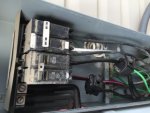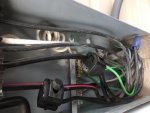bcl
Member
- Location
- Garden Ridge, TX
- Occupation
- Electrician (Owner/ Operator)
I have a 125a MLO meter pack w/ a 100a breaker feeding theelectrical panel inside the house, and two more spaces taken up by a 2-pole 50aGFCI breaker that I’m assuming feeds a hot tub. Additionally, there is a feedertap that goes to an unknown load. Not having been on site (I’m looking atsite-survey pics), and assuming that the feeder tap is code compliant (which isdifficult to tell from the pics), I want to make sure I do this right. I’m notopposed to service changes, but I also don’t want to upsell someone justbecause I can’t figure out how to make something work with their current system…
1. Regardless of PV, if I wanted to add a sub-panelin order to get rid of the feeder tap, I’d do a new load-calc based on 220.83,to make sure I could add a subpanel without having to do a service change. Orjust do like most guys do, and add a 50a sub-panel assuming that the sum of thenew loads on the sub panel and the loads inside the house are not going to exceedthe ampacity of the bus-bar before they trip their individual breakers. Thisseems pretty straightforward, right?
2. If I wanted to feed solar into the new subpanel(705.12(D)), do I need to only account for the size of the bus-bar in the subpanel, rated at 125a, and protect it according to 705.12(D)(2)(3)? It seemslike I also need to upsize the wire feeding the sub-panel to the calculated loads+ 125% of the solar load ((705.12(D)(2)(1)(a)). I realize these individualscenarios are easier to work out, but it confuses me when I start thinkingabout trying to size conductors based on the loads + interconnected systems. I’verun into this before when trying to figure out if and how much PV I can add toan existing electrical panel on a substructure.
If these questions are answered in a separate thread, pleasefeel free to direct me to it. Thanks!
1. Regardless of PV, if I wanted to add a sub-panelin order to get rid of the feeder tap, I’d do a new load-calc based on 220.83,to make sure I could add a subpanel without having to do a service change. Orjust do like most guys do, and add a 50a sub-panel assuming that the sum of thenew loads on the sub panel and the loads inside the house are not going to exceedthe ampacity of the bus-bar before they trip their individual breakers. Thisseems pretty straightforward, right?
2. If I wanted to feed solar into the new subpanel(705.12(D)), do I need to only account for the size of the bus-bar in the subpanel, rated at 125a, and protect it according to 705.12(D)(2)(3)? It seemslike I also need to upsize the wire feeding the sub-panel to the calculated loads+ 125% of the solar load ((705.12(D)(2)(1)(a)). I realize these individualscenarios are easier to work out, but it confuses me when I start thinkingabout trying to size conductors based on the loads + interconnected systems. I’verun into this before when trying to figure out if and how much PV I can add toan existing electrical panel on a substructure.
If these questions are answered in a separate thread, pleasefeel free to direct me to it. Thanks!



